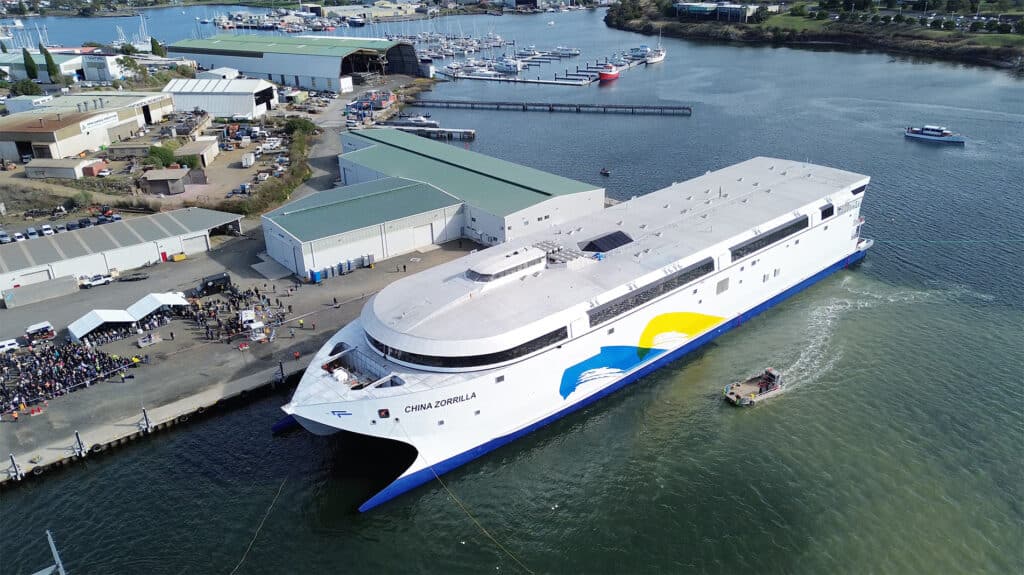Incat Launches the World’s Largest Battery-Electric Ship
Incat Tasmania Pty Ltd announced momentous news on May 2, 2025, that the company has officially launched its “China Zorilla,” Hull 096, the world’s largest battery-electric ship, built for South American ferry operator Buquebus. This game-changing vessel represents a bold leap toward sustainable shipping and marks a proud chapter in Australia’s manufacturing history.
“This is a historic day – not just for Incat, but for the future of maritime transport,” said Incat Chairman Robert Clifford. “We’ve been building world-leading vessels here in Tasmania for more than four decades, and Hull 096 is the most ambitious, most complex, and most important project we’ve ever delivered. This ship changes the game.”
At 130 metres long, Hull 096 is not only the largest electric ship ever built, but also the most substantial electric vehicle of its kind on the planet. Once in operation, it will connect Buenos Aires, Argentina, and Uruguay, transporting up to 2,100 passengers and 225 vehicles entirely on zero-emission, battery-electric power across the River Plate.

This vessel is the ninth constructed by Incat for Buquebus, underscoring a long-standing partnership rooted in innovation and excellence. Tasmanian Premier Jeremy Rockliff praised the milestone, commending Incat’s founder Robert Clifford and his team for their extraordinary craftsmanship and vision.
“Through hard work, determination, and ingenuity, Incat has built a globally significant battery-electric ship from their yard in Tasmania,” Premier Rockliff said.
“For me, it’s a true source of pride to see Buquebus’ vision come to life,” said Buquebus President Juan Carlos López Mena.
“When we were evaluating this new vessel, Robert Clifford told me, ‘The next ship I deliver to you will be 100% electric.’ I replied, ‘Then the next one must be the one we’re commissioning today.’ And with great courage, he said, ‘Together, we’re going to make history.’ That’s how we began reconfiguring the China Zorrilla – originally planned to run on LNG – into a fully electric vessel. It’s a true milestone achieved between private companies, driven by our commitment to sustainability and our ongoing pursuit of service excellence.”
What makes Hull 096 truly revolutionary is its Energy Storage System (ESS) – over 250 tonnes of batteries delivering more than 40 megawatt-hours of installed capacity. That’s four times larger than any previous maritime battery system ever installed. The advanced ESS powers eight electric waterjets, thanks to Incat’s collaboration with energy technology leader Wärtsilä. Together, they are setting a new global standard for green marine propulsion.
Beyond its propulsion, the ship also offers unmatched onboard amenities, including a 2,300-square-metre duty-free shopping deck – the largest retail space ever featured on a ferry.
While the ship’s hull is now complete, work continues on its interior fit-out, battery installation, and final system integration. Sea trials are expected to take place later this year on the River Derwent.
With Hull 096, Incat hasn’t just built a ship — it has delivered a bold statement on the future of sustainable transport and solidified its role as a world leader in high-speed, zero-emission vessel construction.
“Incat has moved the needle dramatically in marine decarbonization by showing what can be done with existing technology, and producing the world’s largest battery electric ship by far. The capability to move hundreds of vehicles and thousands of passengers while producing almost zero emissions is an incredible feat. It also puts a spotlight on communities in Uruguay and Argentina that are leading the way in clean large scale marine transport,” said Justin Dalinger, Founder of electric boat media platform Aqua Lectric.
